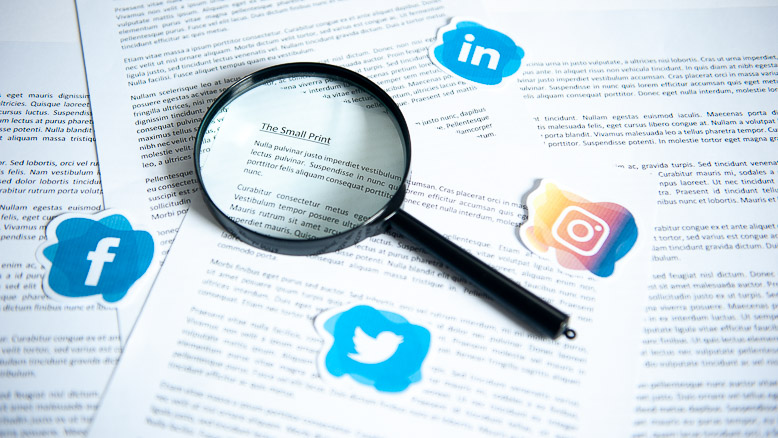Who reads social media small print in detail when they sign up? Not many people that’s for sure. When faced with the pages of waffle most of us skip to the bottom and press agree. Blindly believing that organisations only have our interests at heart wanting to connect us with our nearest and dearest. For this post I delve into the murky depths of social media small print to show you what you agreed to when you signed up. And what you agreed to let the likes of Facebook, Instagram, Twitter and Linkedin do with your work. This post focuses on the rights you assign to these providers relating to the photographs you post on their platforms and how you can be unwittingly giving away your work for free.
Before I get into details, service agreements use the terms copyright and licence, if you aren’t familiar with these terms please read my post Copyright and Photography which explains them in detail.
Who Owns the Copyright?
All four providers mentioned above agree that you retain the copyright of any material that you post. This material can be photographs, drawings, your written words, videos or audio. But by signing up to and using these platforms you grant these organisations a license to use your material, free-of charge. We need to grant this type of licence in order for these platforms to be able to provide the service. But we are unwittingly giving them free use of our imagery. For them to use our work and to sub-licence it to third parties.
The Dangers
The dangers of posting photographs online were highlighted in a recent case in New York. A professional photographer posted her images on Instagram and was approached by a media outlet to use the images in an article. They offered a paltry sum which the photographer refused. The company side-stepped the law by then embedding the Instagram post in their website at no cost. The court case ruled that under the terms of use this was a perfectly legitimate sub-license issued by Instagram. The full article can be read here.
The Small Print
So what do four of the largest social networks in the world expect you to sign away when you sign up to use their services. The following extracts are taken from the terms of service of the four providers. If you want to read more, links to the full terms of use are given below each extract.
Facebooks Terms State:
We need certain permissions from you to provide our services:
Permission to use content that you create and share: ….. when you share, post or upload content that is covered by intellectual property rights on or in connection with our Products, you grant us a non-exclusive, transferable, sub-licensable, royalty-free and worldwide licence to host, use, distribute, modify, run, copy, publicly perform or display, translate and create derivative works of your content.
Instagram being part of the Facebook group uses very similar wording:
Permissions You Give to Us. As part of our agreement, you also give us permissions that we need to provide the Service.
We do not claim ownership of your content, but you grant us a license to use it……. when you share, post, or upload content that is covered by intellectual property rights (like photos or videos) on or in connection with our Service, you hereby grant to us a non-exclusive, royalty-free, transferable, sub-licensable, worldwide license to host, use, distribute, modify, run, copy, publicly perform or display, translate, and create derivative works of your content.
Linkedin states the following in their user agreement:
You own all of the content, feedback and personal information you provide to us, but you also grant us a non-exclusive license to it.
……you own the content and information that you submit or post to the Services, and you are only granting LinkedIn and our affiliates the following non-exclusive license:
A worldwide, transferable and sublicensable right to use, copy, modify, distribute, publish and process, information and content that you provide through our Services and the services of others, without any further consent, notice and/or compensation to you or others.
Twitter’s terms state:
You retain your rights to any Content you submit, post or display on or through the Services. What’s yours is yours — you own your Content (and your incorporated audio, photos and videos are considered part of the Content).
By submitting, posting or displaying Content on or through the Services, you grant us a worldwide, non-exclusive, royalty-free license (with the right to sublicense) to use, copy, reproduce, process, adapt, modify, publish, transmit, display and distribute such Content in any and all media or distribution methods now known or later developed
The Conclusion
So what does all this mean for photographers and other content creators. Should we stop using these sites completely to protect our work? Or does this prevent us from accessing a valuable easily accessible audience for our work? It is clearly a fine balance between exposure and exploitation. And an area that generates more questions than answers.
My advice would be to continue to post but be fully aware of the terms you agree to on these platforms, only post low resolution images and use your watermark wherever possible.
Picture Content Credit:
Social Media Icons: Designed by yolypakoro / Freepik
Other Posts you Might Find Interesting
-
Questions about Copyright
-
Copyright and Photography
-
Stock Photography available to License
-
Women in Business Stock Photography available to License


